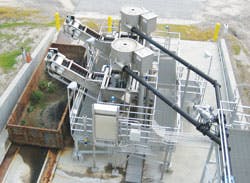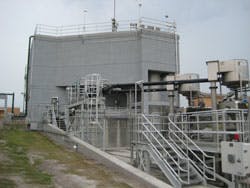A new grit removal system at the James B. Messerly Water Pollution Control Plant (WPCP) in the city of Augusta, S.C., was installed following rigorous independent testing of grit particle size and settling velocity prior to installation of a new stacked tray system, together with grit washing and dewatering.
The new system showed far better removal efficiency, which improved both clarifier and digester operation. The primary clarifier can now be used to thicken the sludge since the grit has been removed. This helps the digester, as less overall sludge volume allows for a longer solids residence time, which has improved volatile solids destruction.
The WPCP treats sanitary flow from the metropolitan area. Forty permitted industrial users make the plant influent high in biological oxygen demand (BOD) and ammonia.
When a grit removal upgrade was planned, the operator wanted to base the design of the new grit system on data. The city and its engineer hired an independent testing company to characterize its grit. Analyses of grit entering the plant and following the Mechanically-Induced Vortex (MIV) grit system were performed.
As a result, particle size and settling velocity could be used to select the correct target particle size for the new system. During the testing, 70 to 76 percent of the grit collected had a physical size of 212 microns and larger, and 45 to 50 percent was between 300 and 820 microns, so the influent grit gradation was relatively coarse. But as much as 43 percent of the influent grit settled at the same velocity as a 106-micron sphere of clean sand.
As is the case in virtually all wastewater treatment plants, the grit particles settled much more slowly than their physical size would indicate. Grit is typically an irregularly-shaped particle, which reduces its settling velocity. Additionally, grit is composed not only of silica sand but often of other components such as gravel, concrete, minerals, and other materials with specific gravities less than 2.65 -- the conventional design assumption.
Based on the data collected, it was determined that the new system would be designed to remove 95 percent of all grit 106 microns and larger in order to capture in excess of 70 percent of the incoming grit. Three Hydro International Eutek HeadCell® grit removal units, each with 12 stacked trays 12 feet in diameter, were installed together with Eutek SlurryCup™ and Eutek Grit Snail® grit washing and dewatering systems. The solution is capable of retaining target cut-point size while yielding low volatile solids output grit.
The system was designed to remove 95 percent of all grit 110 microns and larger at a peak flow rate of 38.6 million gallons per day (MGD) per unit. The existing MIV system remained with its effluent pumped to the HeadCell system.
Processing an average flow rate of 31 MGD and a peak of 46 MGD, the new system removes an additional 8-12 yd3/week of grit, or approximately 1.0-1.24ft3/MG -- almost 10 times the amount removed by the MIV system.
ESG Operations Inc., operates the plant for Augusta. Percy Nolan, operations manager, said, "It is literally amazing how much grit the system is removing -- as much as 16 yards per week."
For advice, knowledge or grit removal product information, email [email protected], or visit www.hydro-int.com.
Hydro International is an exhibitor at WEFTEC.14 and can be found at Booth 2317. For more information, visit www.hydro-int.com.





